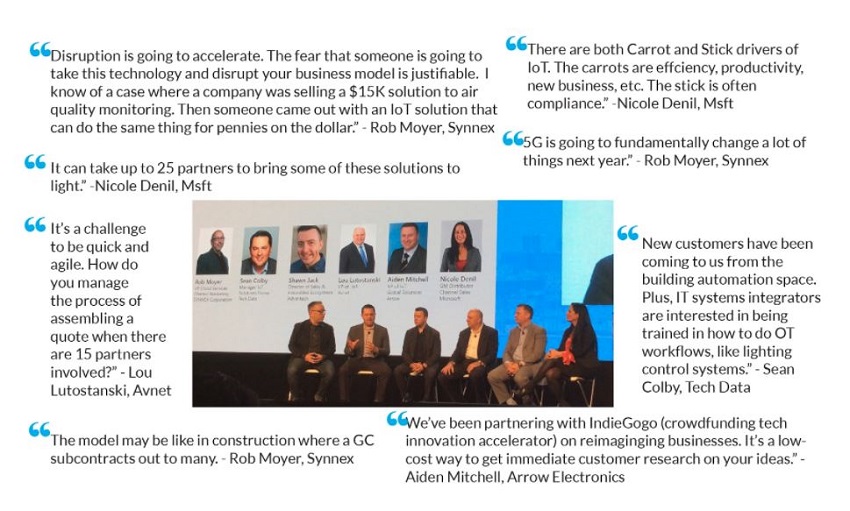|
March 2018
AutomatedBuildings.com
|
[an error occurred while processing this directive]
(Click
Message to Learn More)
|
|
Shaking Value Chains and
Channeling New Voices in BAS
What are 15+ IoT partner value chains trying to conjure up? They want
Cortana, Alexa or Siri in our walls telling us everything that needs
attention in our buildings.
|
 Therese Sullivan, Therese Sullivan,
Principal,
|

John Leech [CC0], via Wikimedia Commons
Charles Dickens
was right. One of the best ways to tell a story is to
channel different voices for past, present and future perspectives. For
this telling, I’m casting those in building automation hoping for
business-as-usual in the role of Ebenezer and the physical security
industry as Jacob Marley’s ghost. This time, Marley isn’t in chains.
Rather, he is pointing out that, once building operational data is
moved to IP networks, there are no chains on alternate sales channels
into C-suites where decisions about buildings are made.
I was briefed on the history of how data architectures for physical
security systems evolved when I met Brad Kult, Associate Vice President & Director
of Technology Design Services, HGA Architects and Engineers, in January
at the AHR Expo Education sessions. Brad explained it
this way:
“Why did
Physical Security Transition to IP networking? Market pressure came
from fierce competition in CCTV cameras and other system components
that drove the industry to commodity pricing for IP-based hardware,
eventually away from expensive proprietary head-ends. Once all
of the hardware supported standard IP connectivity, systems were no
longer closed and new integration opportunities opened up. As for
software, that underwent a major transition too. Classic video matrix
switches began to be replaced by virtual matrix software using the IP
network to provide aggregation and transmission of video from cameras
and recording platforms.”
Brad was quick to see other similarities that will drive BAS solution
vendors and systems integrators along a similar path:
“Just as BAS
applications and analytics are being pushed to edge controllers,
analytics moved into cameras and access control devices. Low-cost
computing power and miniaturization allowed affordable cameras with
better thermal management, solid-state storage and lots of memory.
Likewise, because access control is subject to issues like transaction
latency, buffering in the controller, operating through power and
network outages. As soon as access control devices could be built with
the right compute resources, analytics moved to the edge.”
Brad Kult’s description of past dynamics in physical security jibed
with a January post on the Physical Security business by
Memoori Research. I recommend that you read the whole post; but, here
are the key points from the market analysis:
“Virtually all
the security, safety and environmental controls in smart buildings now
operate through IP Networks and this makes connectivity between them
much more practical, but it still needs a common communication protocol
to be used to enable data to be transferred and understood…[Once we
have] the final link in this chain... [we can] join all the devices on
a two directional network that can operate without human
intervention... that we can call a Building Internet of Things (BIoT).
“We have
almost reached the point where the technology to deliver BIoT solutions
is in place but the channels to market need to be developed...There is
now sufficient evidence to show that growth is not being limited by
demand but is being restricted by limitations in the capability of the
supply chain to deliver and service reliable systems…”
The real Jacob-Marley chain shaking part of this Memoori piece is in
this paragraph:
“The main
route to market for total solutions is at present direct to the end
user or his consultant but Systems Integrators (SI) are now active in
promoting this business and this has opened up a second channel. In the
US some of the Major SI’s have now got involved in the design and
installations of not just physical security systems but further
integrating environmental controls and lighting.”
As Memoori reports, the major IT SI’s have extended their businesses to
include physical security services and audio-visual services as a
natural outcome of IT Convergence, and they are quickly moving into
lighting. A case in point is this recent press announcement from a division of IT SI
major Tech Data detailing an extended partnership with Crestron
Electronics for Microsoft Skype-powered conference-room AV equipment.
Crestron is also a major brand of lighting control and other office
building automation systems, so the opportunities to extend this
partnership to other IoT or as-a-service solutions are many.
For the voice of IT Convergence Future, you can hear an expert on
enterprise IT channel selling on a recent ControlTalk podcast. Rauline Ochs of the Channel
Company sees IT and Operational partners teaming together to bring
new aggregated IoT solutions to market. She describes their playbook
like this:
“Starting with
expertise in edge devices and vertical industry domain knowledge, some
OT companies will move to deliver control units to their customers.
From control, they will move to IoT platforms, so that they can get
involved in analytics. If they can succeed with customers on the basis
of superior analytics - delivering high value from connected things,
extracting insights, impelling action - they can control the customer
ROI. If they control the ROI, they control the sale and are higher in
the value chain among many partners.”
I glimpsed just how close the buildings world is to this future when I
went to the Microsoft IoT in Action Conference in San
Francisco in mid-February. Primarily the event showcased the Microsoft
Azure IoT platform and new AI tools. But, far and away, the most
information-rich session of the day was the industry panel featuring
some of the major IT SI’s using the Azure platform and tools.
This panel was moderated by Nicole Denil, Microsoft’s GM of the
Aggregator Channel, and included IoT leaders from Arrow Electronics,
Tech Data, Synnex, Avnet and Advantech. The IoT deployments they
described were right out of the Playbook described by Rauline Ochs of
Channel Company. Here are some of the stand-out quotes from this panel.

The session on IoT Business Model Transformation featured a physical security company, Genetec.
The company's IoT leader, Christian Morin, detailed the process of
remaking a business to leverage IoT workflows. Genetec has established
a new brand for its cloud-based video monitoring system, Stratocast.
Here you can start to see all the ways it is forging a new route to
profitability - from hardware margin to subscription, from capex to
capex plus opex. Also, Morin talked to how the relationship to the
customer must change from transactional to a partner that is
sufficiently trusted to keep renewing the service. Some call that a Managed Service-type relationship.
The
comparison of physical security industry dynamics to BAS has its
limitations. To date, there has been no direct sales model for BAS
because of the skill set required to integrate HVAC designs unique to a
building involving equipment of competing brands. In BAS IoT, the major
value in the solution will still likely come from OT partners—like
energy and commissioning service contractors, mechanical contractors,
and controls contractors of various sizes, brands, and capabilities.
Though security systems can be complex, they are more self-contained
and thus have often been managed within the realm of a sophisticated IT
or internal services group. So it's no surprise that IT
Convergence has come to these workflows first. Still, BAS OT
partners can learn from the Genetec Business Model Transformation
story. They need a data road map and data playbook too. But, it is
their physical presence and ability to tend to the needs of a buildings
inner workings that position them for the Managed-Service relationship.
Microsoft
noted several times during the conference that it can take from 15 to
25 IT-expert and OT-expert partners to comprise a successful IoT
workflow. That is unprecedented. Today, the IT big-brands are
transparent about wanting only to offer the tooling —
infrastructure-as-a-service, platform-as-a service, big-data and
eventually AI tools. The major value in the solution will come from OT
partners. What are these 15+ IoT partner value chains trying to conjure
up? They are clear about that too; they want Cortana, Alexa or Siri in
our walls telling us everything that needs attention in our buildings.
To make it work, all partners need to be open and transparent in their
business practices and contributing technologies. As the big-brand
cloud providers compete, they are driving such tooling - even the AI
and voice components - to commodity status. Like Genetec, OT partners
can maintain their upper-hand position and own the customer
relationship, delivering the high-value managed service part of the
offering. That is, if they are awake to the industry transformation
underway. So it can be a happy ending for those building automation
solution providers and SIs who, like Ebenezer, wake up and seize
tomorrow.
footer
[an error occurred while processing this directive]
[Click Banner To Learn More]
[Home Page] [The
Automator] [About] [Subscribe
] [Contact
Us]
 Therese Sullivan,
Therese Sullivan,